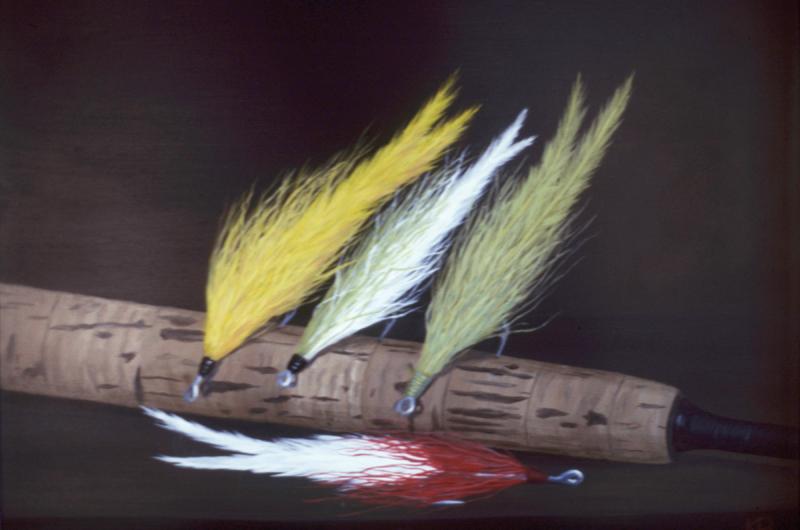Many of today’s saltwater flies look so real that you’d swear they were actual baitfish. Space-age synthetic materials that closely imitate the color and sheen of live bait, plastic eyes, epoxy heads, and the talent of hundreds of skilled professional and amateur fly tiers combine to create a vast choice of excellent flies that fool multitudes of game fish.
Yet one has to wonder if the realistic sophistication of modern flies actually translates into greater angler success than their simpler predecessors from the 1970s, when I took up this sport. There were few commercially produced saltwater flies back then, and we mostly tied our own with feathers and bucktail like those in the accompanying painting. Some outstanding catches were made with early striper flies, such as the many big bass up to 43-pounds caught by author/angler Frank Daignault at Provincetown in the mid-’70s on a sandeel imitation consisting of seven white hackles lashed to a 2/0 hook. And I beached 43- and 40-pounders here on the Vineyard on homemade Lefty’s Deceivers in the early ’80s

Iconic fly tier, angler, artist, and author Ken Abrames (who has a fly rod 48-pound striper to his credit) wrote the following passage in his 1999 book A Perfect Fish, Illusions in Fly Tying:
“A fly that is an example of technical perfection may or may not be beautiful. If it appears to you as technically perfect at first glance then perhaps something is missing. A fly must have the look of life, the feel of being alive, the illusion of being. If it does not have this quality it is like a computer voice on the phone, something important is not there and this lack is disturbing, and interestingly the awareness of the lack comes through a feeling.”
In addition to the mechanics of tying a lifelike fly, I think he was talking about zen or karma or whatever you want to call a somewhat mystical awareness that is imparted to works of art, which his flies certainly are.
Legendary Vineyard angler Roberto Germani was immersed in the zen of fly tying and christened his flies with quasi-Biblical names. In 1984 he landed a 40-pound striper at Dogfish Bar with a fly he named Mary Magdelene’s Little Sister With Lipstick. He gifted me one of those flies, but I’ve never dared to cast it.
And last year this magazine’s editor, Paul Schneider, won the boat fly rod striper division of the derby with a long, slinky yellow fly that bore absolutely no resemblance to a real baitfish, but had so much zen it gave the illusion of being something alive and irresistible.




